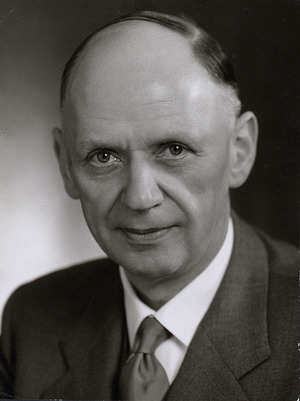Jakob Ackeret facts for kids
Quick facts for kids
Jakob Ackeret
|
|
|---|---|

Jakob Ackeret (1955)
|
|
| Born | 17 March 1898 Zurich, Switzerland
|
| Died | March 27, 1981 (aged 83) Küsnacht, Switzerland
|
| Nationality | Swiss |
| Citizenship | Swiss |
| Alma mater | ETH Zurich |
| Awards | Timoshenko Medal (1969) Daniel Guggenheim Medal (1970) |
Jakob Ackeret (1898–1981) was a famous Swiss aeronautical engineer. He is known as one of the most important experts in the field of aeronautics during the 20th century. Aeronautics is the science of designing and flying aircraft.
Contents
Early Life and Education
Jakob Ackeret was born in 1898 in Switzerland. He studied mechanical engineering at ETH Zurich, a top university. He earned his diploma in 1920.
After his studies, from 1921 to 1927, he worked with Ludwig Prandtl. Prandtl was a very important scientist in the study of how fluids move. Ackeret worked at the "Aerodynamische Versuchsanstalt" in Göttingen, Germany. This was a key time for developing modern fluid dynamics, which is the study of how liquids and gases flow. Ackeret received his PhD from ETH Zurich in 1927.
Academic Career
After getting his PhD, Ackeret joined Escher Wyss AG in Zurich. He became the chief engineer for hydraulics. Hydraulics is about how liquids move and transfer force. He used his knowledge of aerodynamics to design better turbines. Turbines are machines that spin to create power, often used in power plants.
In 1931, Ackeret became a professor at ETH Zurich. He taught Aerodynamics, which is the study of how air moves around objects, especially aircraft. One of his students was Wernher von Braun, who later became a famous rocket scientist.
Important Research
Ackeret was an expert on gas turbines. These are engines that use burning gas to spin a turbine and create power. He also did important research on propellers. Propellers are the spinning blades that push ships and airplanes forward. He also studied problems related to high-speed flight.
While at ETH Zurich, Ackeret helped solve real-world engineering problems. For example, he worked on designing propellers that could change their angle. This helped both ships and airplanes move more efficiently. One of his most important inventions was a special type of gas turbine that used a closed circuit. He developed this with C. Keller.
Supersonic Flight Discoveries
Ackeret also made big contributions to the study of supersonic aerodynamics. This is the study of how things fly faster than the speed of sound. He was a leader in figuring out how to calculate the lift and drag on a supersonic airfoil. An airfoil is the shape of a wing or propeller blade. Lift is the force that pushes an aircraft up, and drag is the force that slows it down.
He also suggested using the term "Mach number" to describe how many times faster an object is than the speed of sound. For example, Mach 1 is the speed of sound, and Mach 2 is twice the speed of sound.
At a conference in Rome in 1935, Ackeret planned to talk about supersonic lift. However, due to some important developments, another scientist named Adolf Busemann presented a different idea. Busemann talked about swept wings, which are wings angled backward. This idea seemed unusual at the time but later became very important for high-speed aircraft. Ackeret also helped design a supersonic wind tunnel, which is a special tunnel used to test how objects behave at very high speeds.
Awards and Recognition
Jakob Ackeret received several important awards for his work.
- In 1965, he was given the Ludwig-Prandtl-Ring. This award is from the German Society for Aeronautics and Astronautics. It recognizes outstanding contributions in aerospace engineering.
- In 1969, he received the Timoshenko Medal.
- In 1970, he was awarded the Daniel Guggenheim Medal.
- In 1976, he became a foreign associate member of the American National Academy of Engineering. This honor was for his deep understanding of high-speed and supersonic fluid mechanics. His work led to major improvements in the science of flight.

